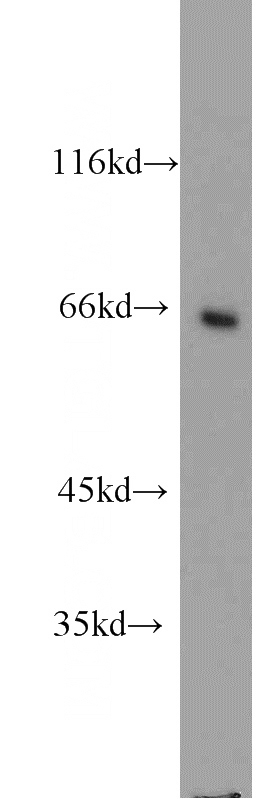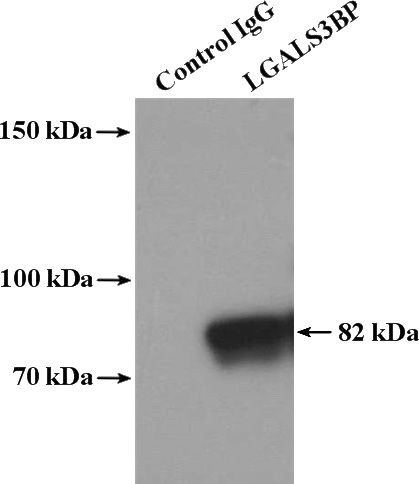-
Product Name
LGALS3BP antibody
- Documents
-
Description
LGALS3BP Rabbit Polyclonal antibody. Positive WB detected in COLO 320 cells, HEK-293 cells, HeLa cells. Positive IP detected in HepG2 cells, HEK-293 cells. Observed molecular weight by Western-blot: 65-90 kDa
-
Tested applications
ELISA, WB, IP
-
Species reactivity
Human; other species not tested.
-
Alternative names
90K antibody; BTBD17B antibody; Galectin 3 binding protein antibody; LGALS3BP antibody; M2BP antibody; Mac 2 binding protein antibody; MAC 2 BP antibody; MAC2BP antibody; Tumor assOCiated antigen 90K antibody
-
Isotype
Rabbit IgG
-
Preparation
This antibody was obtained by immunization of LGALS3BP recombinant protein (Accession Number: NM_005567). Purification method: Antigen affinity purified.
-
Clonality
Polyclonal
-
Formulation
PBS with 0.1% sodium azide and 50% glycerol pH 7.3.
-
Storage instructions
Store at -20℃. DO NOT ALIQUOT
-
Applications
Recommended Dilution:
WB: 1:200-1:2000
IP: 1:200-1:1000
-
Validations

COLO 320 cells were subjected to SDS PAGE followed by western blot with Catalog No:112205(LGALS3BP antibody) at dilution of 1:1000

IP Result of anti-LGALS3BP (IP:Catalog No:112205, 4ug; Detection:Catalog No:112205 1:300) with HepG2 cells lysate 3480ug.
-
Background
The galectins are a family of beta-galactoside-binding proteins implicated in modulating cell-cell and cell-matrix interactions. LGALS3BP is a widely expressed, secreted galectin. It has been found elevated in the serum of patients with various types of breast, lung, colorectal, ovary, and endometrial cancer, and in those infected by the human immunodeficiency virus (HIV). High expression levels of LGALS3BP are associated with a shorter survival, the occurrence of metastasis or a reduced response to chemotherapy. The native protein binds specifically to a human macrophage-associated lectin known as Mac-2 and also binds galectin 1. It appears to be implicated in immune response associated with natural killer (NK) and lymphokine-activated killer (LAK) cell cytotoxicity. Immunoblotting showed that LGALS3BP is likely contained in breast milk, serum, semen, saliva, urine, and tears.
-
References
- Silverman AM, Nakata R, Shimada H, Sposto R, DeClerck YA. A galectin-3-dependent pathway upregulates interleukin-6 in the microenvironment of human neuroblastoma. Cancer research. 72(9):2228-38. 2012.
- Liu LT, Lang ZF, Li Y. Composition and characteristics of distinct macrophage subpopulations in the mouse thymus. Molecular medicine reports. 7(6):1850-4. 2013.
- Jeoung M, Jang ER, Liu J. Shoc2-tranduced ERK1/2 motility signals - Novel insights from functional genomics. Cellular signalling. 28(5):448-459. 2016.
- Blostein M, Cuerquis J, Galipeau J. Galectin 3-binding protein is a potential contaminant of recombinantly produced factor IX. Haemophilia : the official journal of the World Federation of Hemophilia. 13(6):701-6. 2007.
- Smalley DM, Root KE, Cho H, Ross MM, Ley K. Proteomic discovery of 21 proteins expressed in human plasma-derived but not platelet-derived microparticles. Thrombosis and haemostasis. 97(1):67-80. 2007.
- Gorla L, Mondellini P, Cuccuru G. Proteomics study of medullary thyroid carcinomas expressing RET germ-line mutations: identification of new signaling elements. Molecular carcinogenesis. 48(3):220-31. 2009.
- Isono T. O-GlcNAc-specific antibody CTD110.6 cross-reacts with N-GlcNAc2-modified proteins induced under glucose deprivation. PloS one. 6(4):e18959. 2011.
- Kashyap MK, Harsha HC, Renuse S. SILAC-based quantitative proteomic approach to identify potential biomarkers from the esophageal squamous cell carcinoma secretome. Cancer biology & therapy. 10(8):796-810. 2010.
Related Products / Services
Please note: All products are "FOR RESEARCH USE ONLY AND ARE NOT INTENDED FOR DIAGNOSTIC OR THERAPEUTIC USE"
